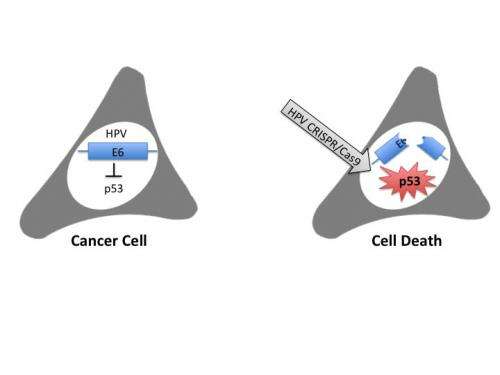Editing HPV's genes to kill cervical cancer cells

Researchers have hijacked a defense system normally used by bacteria to fend off viral infections and redirected it against the human papillomavirus (HPV), the virus that causes cervical, head and neck, and other cancers.
Using the genome editing tool known as CRISPR, the Duke University researchers were able to selectively destroy two viral genes responsible for the growth and survival of cervical carcinoma cells, causing the cancer cells to self-destruct.
The findings, appearing online August 7 in the Journal of Virology, give credence to an approach only recently attempted in mammalian cells, and could pave the way toward antiviral strategies targeted against other DNA-based viruses like hepatitis B and herpes simplex.
"Because this approach is only going after viral genes, there should be no off-target effects on normal cells," said Bryan R. Cullen, Ph.D., senior study author and professor of molecular genetics and microbiology at Duke University School of Medicine. "You can think of this as targeting a missile that will destroy a certain target. You put in a code that tells the missile exactly what to hit, and it will only hit that, and it won't hit anything else because it doesn't have the code for another target."
The CRISPR targeted system was only discovered a decade ago. Looking at the genomes of different types of bacteria, researchers had noticed long stretches where the same genetic sequence was repeated. In between these repeats lay DNA sequences that differed from bacteria to bacteria. Scientists figured out that these unique sequences—known as clustered regularly interspaced short palindromic repeats or CRISPR—were derived from viruses that had previously infected the bacteria.
Essentially, each time bacteria are infected, they copy a bit of the offending viral DNA and tuck those sequences between the repeat elements for future reference. Those sequences then provide a hit list for a bacterial protein called Cas9, which acts as a kind of hired gun, cutting up and destroying any recognized offenders before they can hurt the bacteria again.
Recently, several laboratories have shown that they can retarget the CRISPR system for their own purposes; some to introduce mutations they would like to study in model organisms, others to repair genetic defects like those in a gene called DMD that is involved in muscular dystrophy.
In this study, Cullen decided to target the human papillomavirus (HPV), which causes almost all cervical cancers and about half of head and neck cancers. Specifically, he and his colleagues went after the viral genes E6 and E7, two "oncogenes" that block the host's own efforts to keep cancer cells at bay.
To run CRISPR against the virus, the researchers needed two ingredients. First, they needed the target code for E6 or E7, consisting of a short strip of RNA sequence, the chemical cousin of DNA. To this "guide RNA" they added the Cas9 protein, which would cut any DNA that could line up and bind to that RNA sequence.
In an ironic twist, the researchers then packaged this antiviral concoction into a viral vector based on a disabled version of HIV. They infected cervical carcinoma cells in a lab dish with this genetically engineered virus and assessed whether it could effectively destroy HPV infection and block cancer cell growth.
The carcinoma cells that received the anti-HPV guide RNA/Cas9 combination immediately stopped growing. In contrast, cells that had received a control virus, containing a random guide RNA sequence, continued on their path to immortality.
The researchers then dug down to the molecular level to investigate the consequences of destroying E6 or E7 in cancer cells. E6 normally blocks a protein called p53, known as the guardian of the genome because it can turn on suicide pathways in the cell when it senses that something has gone awry. In this study, targeting E6 enabled p53 to resume its normal function, spurring death of the cancer cell.
E7 works in a similar way, blocking another protein called retinoblastoma or Rb that can trigger growth arrest and senescence, another form of cell death. As expected, the researchers found that targeting E7 also set this second "tumor suppressor" back in motion.
"As soon as you turn off E6 or E7, the host defense mechanisms are allowed to come back on again, because they have been there this whole time, but they have been turned off by HPV," Cullen said. "What happens is the cell immediately commits suicide."
Cullen and his colleagues are now working on developing a different viral vector, based on the adeno-associated virus, to deliver their CRISPR cargo into cancer cells. Once they are happy with their delivery system, they will begin to test this approach in animal models.
"What we would hope to see in an HPV-induced cancer is rapid induction of tumor necrosis caused by loss of E6 or E7," Cullen said. "This method has the potential to be a single hit treatment that will dramatically reduce tumor load without having any effect on normal cells."
The researchers are also targeting other viruses that use DNA as their genetic material, including the hepatitis B virus and herpes simplex virus.
More information: "Inactivation of the human papillomavirus E6 or E7 gene in cervical carcinoma cells using a bacterial CRISPR/Cas RNA-guided endonuclease," Edward M. Kennedy, Anand V. R. Kornepati, Michael Goldstein, Hal P. Bogerd, Brigid C. Poling, Adam W. Whisnant, Michael B. Kastan and Bryan R. Cullen. Journal of Virology, August 6, 2014. DOI: 10.1128/JVI.01879-14
















